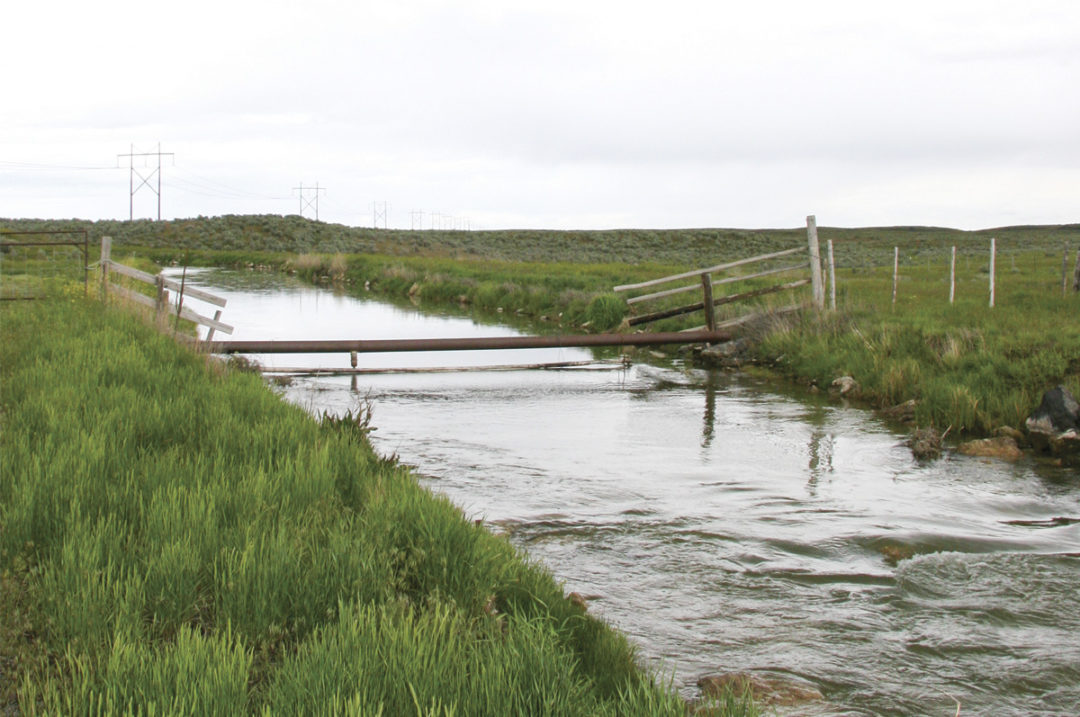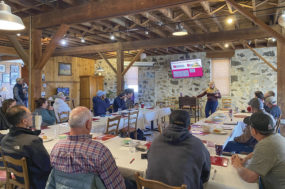Idaho Department of Water Resources Deputy Director Mat Weaver provided an update to attendees at the Water Law and Resources Issues Seminar on the Eastern Snake Plain Aquifer, including the new methodology used for the Surface Water Coalition (SWC) water call to determine the annual injury to senior surface water users by junior groundwater pumping.
Background
The aquifer and the discharges in the Thousand Springs area (which are highly correlated) grew from 1912 to the early '50s; since the mid-'50s they have been in steady decline. In the general decline, there have been ups and down, with the downs typically related to multiyear droughts, after which there is some post-drought recovery, but it never quite gets back to the stage where it was prior to the droughts.
Over the last 25 years, the Eastern Snake Plain Aquifer model has been developed and refined for planning efforts, recharge evaluation and as a component of making delivery calls and determining priority curtailment dates.
Groundwater districts (statutorily authorized and approved entities that allow for junior groundwater users to collectively respond to and mitigate for delivery calls) were established with its umbrella organization – Idaho Groundwater Association (IGWA) – and help orchestrate activities of the districts.
Water calls began in the early 1990s; however, that first call wasn’t administered because there weren’t conjunctive management rules in place at the time. In response, Idaho developed and adopted conjunctive management rules, with the Legislature authorizing them in 1995. In the early 2000s, more delivery calls were filed. In 2005 alone, there were six delivery calls filed. The Surface Water Coalition delivery call was one of the six filed in 2005 and addressed declines in surface water supply on the Snake River above Milner Dam, from junior groundwater pumping. At that time, a methodology playbook was developed, by which the department could determine, in any given year, if injury (and what quantity of injury) existed from junior-rights groundwater pumping against senior surface water rights. The department’s initial methodology order was appealed through the court system, resulting in two years of litigation. The order was then remanded back to the department to develop an amended methodology order, which was done.
Under the methodology, two different injury determinations occur during the year. The first is an in-season injury, to determine whether senior surface water users are being injured during the irrigation season to the water supply available to them. The second (determined by the courts) says senior surface water users are entitled to carry over storage water from one year to the next; so at the end of the irrigation season, the department looks at how much carryover storage is in the reservoirs and whether there is injury to the SWC’s carryover.
Under the methodology, the department must forecast what the water supply is in any given year and forecast demand of the senior irrigators. When the supply is not sufficient to meet demand, an injury exists. The department determines and quantifies the amount of injury each year in April, July and in July or August (at what is deemed the time of need when injury actually occurs). The department calculates the actual injury at the end of the season when, with the advantage of hindsight, it knows what the water supplies and diversions were during the irrigation season.
A third amendment was made to the order in 2015, in response to additional court directives. These changes resulted in calculations of more frequent and larger injury determinations. In the spring of 2015, updates to the methodology, bad water year conditions and record crop irrigation demand requirements in April and May resulted in the largest injury determinations to date. This is when junior groundwater users and the senior users came together and struck a historic settlement agreement that went on to become a mitigation plan for IGWA and the groundwater districts. As a result of the settlement, there was to be a reduction in groundwater pumping of 240,000 acre feet and/or an aquifer recharge in that amount. There was to be a delivery of 50,000 acre feet of water to the senior water rights holders and a number of other components.
The first methodology was issued in 2010 and was amended that same year to remove limits on mitigation of storage water and recognize other mitigation activities. A fourth amendment was made in 2016 for the purpose of determining material injury to storage and natural flow water rights held by or committed to Surface Water Coalition members. Between 2016 to 2020, things went well when there were big water supply years.
In 2021, issues arose in the drought year. It was followed by another bad drought year in 2022. Under these conditions, the initial forecast in April 2021 for “reasonable in-season demand” was 3.2 million acre feet and the shortfall (injury volume) was 40,500 acre feet. In May 2021, the director issued an order curtailing groundwater rights that were not participating in an approved mitigation plan and that were junior to May 30, 1989. In July, based on Step 6 of the methodology, the predicted, revised in-season demand shortfall was 170,000 acre feet. This resulted in a curtailment of groundwater rights, again not participating in an approved mitigation plan, junior to June 14, 1977. In August the “time of need” recalculation was made and the updated predicted demand shortfall was 142,700 acre feet and the curtailment for junior groundwater rights was pushed back to Jan. 21, 1979. And by November, it was determined there was injury to reasonable carryover storage water, the injury resulting in 190,800 acre feet. The November calculations noted injury of 191,000 acre feet – greater than any forecast determination, missing the April calculation (163,000 acre feet) by more than 100,000 acre feet.
The actual injury determination (calculated in November for the previous two years) was larger than any past forecast injuries. The department was concerned the methodology was no longer protecting senior water users and considered amending the methodology. This resulted in the Fifth Amended Methodology Order and significant changes. The Fifth Amended Methodology Order was issued at the same time, as the April 2023 Forecast Supply Methodology (Steps 1-3) or as-applied order, that applies methodology Steps 1-3 to predict reasonable in-season demand and demand shortfall based on the hydrologic and climatic conditions of the year. Some of the changes to the Fifth Amended Methodology Order include:
- More frequent injury to the senior water-rights and larger magnitudes of injury
- Updated the climate, hydrologic and irrigation demand data that gets fed into the model that's used to determine injury
- Revised the baseline year used by the methodology (the old model averaged 2006, 2008 and 2012; the new baseline year is 2018)
- Updated the reasonable carryover volumes
- Changed how the Eastern State Aquifer model was deployed and the methodology of calculated curtailment
By way of explanation, the baseline year is a historic year representing above-average water diversions and is selected to act as the default or analog year for hydrologic conditions and water demand (because in April there’s little data to make projections). Further into the season, actual data is relied upon to estimate in-season demand and demand shortfall more accurately. The baseline year was determined by the courts (giving specific criteria) to adequately protect the senior water rights holders. The criteria are very specific – it has to be a year of above-average diversion, above-average temperature, above-average evapotranspiration and below-average precipitation in a year when the water supply system is not limited. It’s so specific, it’s tough to find that year, which is why in the past an average of years was used. However, the year 2018 fit the bill, so the baseline year was finally able to be updated.
One change from the Fourth to the Fifth Amended Methodology involves steady-state analysis versus transient analysis. Until the Fifth Amended Methodology, the ESPAM model used steady-state analysis to determine how many irrigated acres needed to be curtailed to put a volume of water in the river to satisfy a demand shortfall in the current year at some future day (when the system would be in equilibrium). Many of the irrigated acres that divert groundwater are very proximate to the river, and the impacts of pumping groundwater in proximity to the river are felt very quickly. But many of the farms are tens to a hundred or more miles from the Snake River, and so their impacts on the river are delayed, and often delayed by decades. So it takes a long time when you shut off wells for that impact on the aquifer to fully seep to the river. As a rule of thumb for modeling the ESPA in steady state, it takes approximately 30 years to realize the effects of curtailment in a given year, or in other words it takes 30 years to reach 90% equilibrium in aquifer levels. So the argument against a steady-state scenario is that the injury is not mitigated in time but is being mitigated somewhere into the future (assuming all current conditions remain static until that future point). This was not accurate according to the court’s direction.
The Fifth Amended Methodology implements a transient model analysis, which requires significantly more acres to be curtailed to put the water in the Snake River during the same irrigation season that injuries are determined. This is the most accurate way to respond to the court’s directive. It mitigates injury to the senior rights holder in location and quantity, but also at the time the injury occurs.
Curtailments can be avoided if mitigated for, however. If users enter a mitigation plan, approved by the director, then they are allowed to divert out of priority. Seven mitigation plans are in place across the Eastern Snake Plain right now. There are many junior water rights holders, however, that are not covered by a mitigation plan.
Water call 2023
The April 2023 as-applied order predicted there would be a 75,200 acre feet demand shortfall or volume injury. If no mitigation plans were in place, about 700,000 acres of irrigated land would be affected by a curtailment of groundwater rights junior to senior water rights holders.
Under the methodology order, the junior water rights holders have to demonstrate to the department two weeks after the April Forecast Supply (or as-applied) Order is issued their sufficiency of water supply to meet their mitigation requirements. IGWA timely submitted their notice of mitigation in 2023, but upon review the department determined there were deficiencies in that notice. So the department issued an order on May 23, 2023, outlining the deficiencies in what IGWA submitted and notifying IGWA and its non-participant members they would be curtailed if a curtailment order is issued after the related June 6-10 hearing and they are still not operating in accordance with an approved mitigation plan.
Following the May 23rd order, junior groundwater users affected by the order submitted several motions with Judge Wildman at the District Court that oversees water matters in the state asking for various forms of relief from the department’s actions. Because of the timing of the motions filed with the courts by groundwater users, the fast-approaching irrigation season and the upcoming June hearing on the Fifth Amended Methodology Order, there was a hearing held by the judge in early June and he ruled from the bench, denying the motions. The decision also advised the petitioners that they had not exhausted administrative remedies with the department. At the time of this writing, the director has conducted the June 6-10 hearing and closing briefs have been filed and the director is working on his decision.








